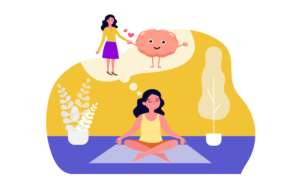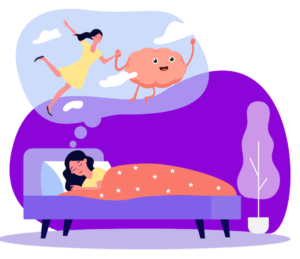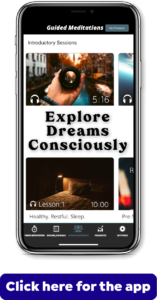Mindfulness has become increasingly integrated into Western culture. In fact, it’s grown so popular, and valuable, that Apple has included Mindfulness as one of the four pillars of health, right alongside Diet, Exercise, and Sleep in HealthKit, as well it should be. In this article, we’re going to look at how and why mindfulness and lucid dreaming go hand in hand.
What exactly is Mindfulness?
It’s is a practice in which we simply tune into our own, present-moment experience and just observe what happens without judging. This helps us cultivate presence of mind, improve our ability to focus, and increase our self-awareness.
Generally, from moment to moment, we tend to think about something that recently happened, or whether we are prepared for some upcoming event. These are moments in which we are focused on the past or the future, rather than on the present. If this happens too often, it can lead to all sorts of problems. But in practicing mindfulness, i.e. meditating, we begin to see the activities of our mind, occurring naturally in a given moment.
This is what it means to “observe the nature of the mind”. We see that our senses and our subconscious are constantly feeding us information, our thoughts pop into awareness, and usually, we react to these thoughts and feelings instinctively, without even realizing it.
So, what is meditating?
Meditating is really simple. It’s just intentionally directing attention to a focal point (like the breath), realizing when attention drifts off target, and then intentionally bringing it back to the focal point. Rinse and repeat. Usually, the breath is used as a point of focus, and for good reasons; one being that it’s always with you and at any time you can focus on the breath.
Try it right now, close your eyes, focus on your breath now, try to do this for just ten seconds… and simply notice what it’s like.
Regardless of what exactly that experience was like for you, meditation reveals, among other things, that we are able to respond mindfully, rather than react mindlessly, to our thoughts or impulses. Even if you didn’t want to stay focused on the breath for the full ten seconds, hopefully, you remained steadfast, despite the: boredom, distractions, urges to open your eyes, thoughts of “Why am I doing this?”… Simply put, that is mindful meditation – watching what the mind is up to when we focus on one thing.
Among other things, this simple discipline shows us that we have a choice in what we do with our attention. And in the moment, we can choose to act or focus in a way that serves us.
Why practice lucid dreaming and mindfulness?
Living mindfully is important because our actions always have consequences. Sure, we can learn from our mistakes and apply what we learned retrospectively, but mindfulness meditation is more about introspection; discovering our predispositions and tendencies. This helps us develop the presence of mind to act more intentionally and wisely, rather than mindlessly in our lives.
Every moment we live adds up to our life story. And by practicing mindful meditation, we learn to pay closer, more deliberate attention from moment-to-moment. So think of it as a tool we can use to help us become better writers of our life story. We sleep for one-third of our lives and we dream every night; do we really want to continue ignoring that much of our story?
Exercise for the mind…
Practicing mindful meditation is very much like exercising; it helps us become more mentally coordinated, more balanced, stable, and capable in otherwise stressful situations. And we can use what we learn from these experiences to our advantage. More familiarity with the nature of our minds yields a stronger relationship with both our selves and with those we care about.
Like I mentioned earlier, practicing mindfulness is already well known, well-researched, and increasingly commonplace in America.
But consider this fact: We are only “awake” for two-thirds of our lives and in traditional mindfulness practices we only practice observing the mind while we’re awake. So let me pose the question: What about the other one third? How familiar are we with the processes of the mind during sleep?
Lucid dreaming compliments mindfulness
Dreaming is something we do every day. It’s necessary for our vitality, our adaptability, and our functionality in the world. Not only is dreaming required for mental stability but at the level of experience, dream content is astonishingly interesting. The dream state is a hyper-creative; the mind generates complex narratives, concepts, situations, etc. for 2 – 3 hours every night, while we sleep.
The mind generates experiences that seem so ‘real’, that at the level of the brain, they’re remarkably similar to active waking brain activity. Sense perception can be fully engaged in the simulated dream experience, and quite often, the experiences are contextually relevant to our waking lives.
Mindfulness is about cultivating awareness of one’s own mind. So, if we’re considering how dreaming relates to mindfulness, the connection should be clear: dreaming is entirely a mental process. It’d be quite an oversight to ignore this mental recurrence while purporting to cultivate awareness of the mind.
Mindful observation in dreams
‘Paying close attention to conscious processes in the present moment without judgment’ is Mindfulness in a nutshell. Lucid dreaming is awareness of the fact that one is dreaming during the dream. It’s different from mindfulness in that there is some judgment involved; we must judge whether we’re dreaming or awake.
When we get to the concept of observing dreams mindfully, we must consider how to observe. Without a strategy or method of observation, dreams remain in the subconscious domain; forgotten, out of sight, out of mind. So, for conscious observation and connection to be possible, one must either recall dreams or become lucid during the dream (and presumably remember them upon awakening).
If the goal is improving familiarity with the dreaming mind, working on dream recall suffices as one method. But lucid dreaming is a far more interesting, engaging, exciting, and rewarding endeavor.
How do I become lucid?
To induce lucidity during the dream-state, we must judge the present moment in order to realize we are dreaming. We question and test our state of reality. “Am I dreaming right now? How do I know for sure? I’ll do a test…” And that’s when we realize it.
We can then influence and create the dream world we want to experience. It’s not dream-control per se, but there is a significant feeling of control involved. When you get lucid, it’s like the lights turn on and all of a sudden, you are in the driver’s seat. You can then do ANYTHING you want, depending, of course, on your level of lucidity.
Upon attaining lucidity, the dream shifts from a subconsciously created world, to a sort of hybrid conscious-subconscious interaction experience dimension… thing. It’s an exhilarating experience, to say the least. And then when the dream ends, you simply wake up (write it down!) and start your day.
Taking a mindful approach to lucid dreaming
Lucid dreaming should at the very least be integrated into mindfulness practices given that mindfulness is a practice of observing and familiarizing with the mind. When we observe the mind during dreams, we get a direct look into our subconscious, and we get to engage with our subconscious. This is an unprecedented opportunity to learn about our mind and integrate with ourselves.
I’d be failing you if I didn’t also mention Dream Yoga, the ancient practice of lucid dreaming within the schools of Tibetan Buddhism. So, mindfulness and lucid dreaming already have this shared ancient lineage.
Though Dream Yoga is still a fairly well-kept secret in the west, lucid dreaming and mindfulness are on the rise. There are many effective methods for initiating lucidity and having that first ‘Ah-Ha!’ moment … but then what? Why is this state of mind important? How do we benefit? What should we do during lucid dreams? And how do we improve and advance our practice?
So many questions arise because mindfulness and lucid dreaming both have so much potential. And it is because of this potential that I created Mind Awake.
The Mindfulness-Based Lucid Dreaming App
Let’s talk about the mobile App. Mind Awake is a Mindfulness-Based Lucid Dreaming course. This is the world’s first Lucid Dreaming app that provides guided, informative audio sessions designed for:
- Improving healthy, restful sleep.
- Teaching mindfulness principles and practices.
- Improving dream recall.
- Inducing and becoming skilled at lucid dreaming.
- Offering guidance and advice on how to use this new skill set to improve and enrich your life.
You’ll see throughout your practice how all these mindfulness and lucid dreaming techniques integrate with each other and how much more to your mind there really is.
 Mind Awake is a working course; it will be developed and improved over time based on feedback from users like you. There are so many potential benefits to lucid dreaming; I hope you’ll share your experiences.
Mind Awake is a working course; it will be developed and improved over time based on feedback from users like you. There are so many potential benefits to lucid dreaming; I hope you’ll share your experiences.
We’ll be adding more interactive, educational courses in related fields (Insomnia, Nightmares, Dream Interpretation, Shadow Work, etc.) but really, please send feedback and ideas – we listen and we want to know about your experience using the app.
The app also features a dream journal, a meditation timer, an option to set reminders to get lucid, and a progress tracker.
The lucid dreaming course
It’s best to use headphones for the guided course. Designate roughly 10 un-interrupted minutes per day to listen to each session in sequential order. These 10 minutes are just for you – consider it to be “Me Time” for relaxing, focusing, and learning something new. Sit with eyes closed, headphones on, and phone on ‘do not disturb’.
It always feels great to disconnect every once in a while, right? And even though, you’re using your phone, you’re not mindlessly scrolling or gaming – you’re exercising your mind and also taking a break from the typical day-to-day routine.
Listen to the Pre-Sleep-Reminders just before bed to prime your mind for lucidity during sleep. Try to listen to one session daily, but don’t worry if you can’t get to it every day, just pick up where you left off whenever you can.
 The most important piece of the practice is to write your dreams down frequently. You can use the dream journal feature or just write them down in a notebook beside the bed. We naturally forget our dreams after we get out of bed, but if you write them down in your journal before you get up, you can re-read and remember those dreams anytime you want. Rinse and repeat, and soon enough you’ll find you are able to remember much more dream content in just a few days.
The most important piece of the practice is to write your dreams down frequently. You can use the dream journal feature or just write them down in a notebook beside the bed. We naturally forget our dreams after we get out of bed, but if you write them down in your journal before you get up, you can re-read and remember those dreams anytime you want. Rinse and repeat, and soon enough you’ll find you are able to remember much more dream content in just a few days.
This simple practice will help you get familiar with your dreams and will serve as a catalog of your subconscious contents; a great resource for better understanding your mind. The rest is easy! Just listen to each session, relax, breathe, and enjoy.
The content and features within the app will improve with the support and feedback from people like you, so please feel free to reach out to support@mindawakeapp.com and let us know your thoughts! Head to the App Store and download now for FREE.

